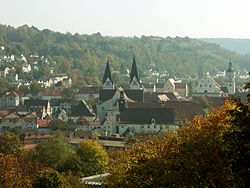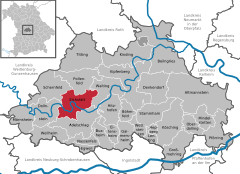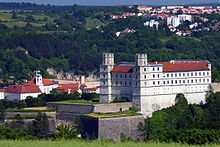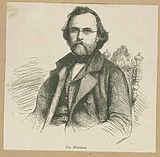Eichstätt
This article needs additional citations for verification. (January 2016) |
Eichstätt | |
|---|---|
 Eichstätt | |
Location of Eichstätt within Eichstätt district  | |
| Coordinates: 48°53′31″N 11°11′2″E / 48.89194°N 11.18389°E | |
| Country | Germany |
| State | Bavaria |
| Admin. region | Oberbayern |
| District | Eichstätt |
| Government | |
| • Lord mayor | Andreas Steppberger (FW) |
| Area | |
| • Total | 47.78 km2 (18.45 sq mi) |
| Elevation | 393 m (1,289 ft) |
| Population (2022-12-31)[1] | |
| • Total | 13,714 |
| • Density | 290/km2 (740/sq mi) |
| Time zone | UTC+01:00 (CET) |
| • Summer (DST) | UTC+02:00 (CEST) |
| Postal codes | 85071, 85072, 85067 |
| Dialling codes | 08421 |
| Vehicle registration | EI |
| Website | www.eichstaett.de |



Eichstätt (German pronunciation: [ˈaɪçʃtɛt], formerly also Eichstädt or Aichstädt) is a town in the federal state of Bavaria, Germany, and capital of the district of Eichstätt. It is located on the Altmühl river and has a population of around 13,000. Eichstätt is also the seat of the Roman Catholic Diocese of Eichstätt.
Geography
Location
Eichstätt lies on both sides of the river Altmühl in the district of Eichstätt of the Oberbayern region of Bavaria, in the heart of Altmühl Valley Nature Park.
Geology
Eichstätt is located at an outlying spur of the Franconian Jura and is famous for the quarries of Solnhofen Plattenkalk (Jurassic limestone). On the Blumenberg the Berlin specimen of Archaeopteryx was found by Jakob Niemeyer.
History
St. Willibald founded the Diocese of Eichstätt on the site of an old Roman station in 741. The city was chartered in 908. It was ruled by a prince-bishop, and in the Holy Roman Empire was the seat of the Bishopric of Eichstätt until secularization in 1802. In 1806, it became a part of the Kingdom of Bavaria. Eichstätt was included as part of the Principality of Eichstätt, which King Maximilian I granted to his son-in-law Eugène de Beauharnais in 1817 and an episcopal see was reestablished in 1821.
In 1943, the painter Karl Friedrich Lippmann moved to Eichstätt and stayed until 1955.
Hortus Eystettensis ("Garden at Eichstätt") is the name of an important botanical book first published in 1613 and written by Basilius Besler.
References: Christianne Hoth and Markus Raasch, editors,Eichstatt im Nationalsozialismus. Katholisches Milieu und Volksgemeinschaft", Aschendorff Verlag, Munster, Germany 2017
Attractions
The town is dominated by the Willibaldsburg. Besides the cathedral, Eichstätt also sports numerous churches and monasteries.
Mayors
- 1944–1945: Hans Rösch
- 1945–1948: Romuald Blei
- 1948–1949: Richard Jaeger CSU
- 1949–1951: Romuald Blei
- 1951–1976: Hans Hutter, CSU
- 1976–1994: Ludwig Kärtner, CSU
- 1994–2012: Arnulf Neumeyer, SPD
- since 2012: Andreas Steppberger, Free Voters Bavaria
Education
Eichstätt is home to the Katholische Universität Eichstätt-Ingolstadt (K-U), the lone Catholic university in Germany. The K-U was founded in 1980, and was granted full rights of a university, including Ph.D. and Habilitation degrees by the State of Bavaria.[2]
Sons and daughters of the town
- Tobias Barnerssoi (born 1969), alpine skier and sports reporter
- Erhard Bauer (died 1493), municipal architect of Eger
- Erich Emminger (1880–1951), politician (center party), minister of justice from 1923 to 1924
- Anton Fils (1733–1760), composer
- Edmund Harburger (1846–1906), Munich draftsman and painter

- Anna Knauer (born 1995), cyclist
- Konrad Kyeser (1366-after 1405), nobleman and war technician of medieval Europe
- Caritas Pirckheimer (1467–1532), abbess in Nuremberg during the Reformation
- Willibald Pirckheimer (1470–1530), lawyer, author humanist
- Max von Widnmann (1812–1895), sculptor and successor of Schwanthaler as professor at the academy of fine arts in Munich (1849–1887)
Personalities connected with the city
- Pope Victor II (Gebhard von Dollnstein-Hirschberg) († 1057), fifth German pope 1055-1057
- Gundekar II of Eichstätt (1019-1075), bishop, church politician, (sarcophagus in the St. John's Chapel of the Cathedral).
- Loy Hering (1484/85-1564), Renaissance sculptor from Kaufbeuren, councilor and mayor in Eichstätt

- Elias Holl (1573–1646), master builder from Augsburg, architect of the Willibaldsburg
- Karl Engel, brother of Jakob Engel, carpenter and builder (1675 pagealtaries of St. Walburg)
- Franz Xaver Witt (1834–1888), church musician, composer, reformer, founder of the general German Cäcilienvereine, 1870-1871 conductor of Eichstätt
- Prince Maximilian of Saxony (1870–1951) (1870–1951), prince of the albertine branch, priestly and chaplain activity in Eichstätt, church researcher
- Cesare Orsenigo (1873-1946 in Eichstätt), from 1930 to 1945 apostolic Nuncio in Germany, successor of Pius XII. (Eugenio Pacelli) as Apostolic Nuncio in Germany
- Karl Friedrich Lippmann (1883–1957), art painter, (New Objectivity), 1943-1955 in Eichstätt
See also
References
- ^ Genesis Online-Datenbank des Bayerischen Landesamtes für Statistik Tabelle 12411-003r Fortschreibung des Bevölkerungsstandes: Gemeinden, Stichtag (Einwohnerzahlen auf Grundlage des Zensus 2011) (Hilfe dazu).
- ^ Catholic University Eichstätt-Ingolstadt ECTS Information Guide, International Relations 15.05.06
External links
 Media related to Eichstätt at Wikimedia Commons
Media related to Eichstätt at Wikimedia Commons- . Encyclopædia Britannica. Vol. 9 (11th ed.). 1911.




